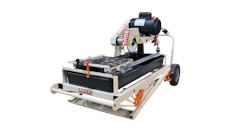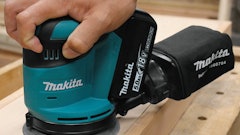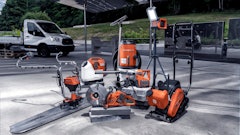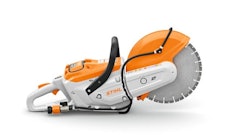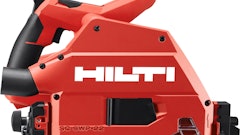
When it comes to cutting concrete, asphalt, tile, brick or other hard materials, choosing the optimal concrete saw and saw blade is critical to maximizing efficiency and ensuring precise, clean cuts. Using the appropriate tool is also vital for the safety of the operator and protection of the equipment. The wrong saw can fatigue the user, increasing the risk of an accident. Trying to force a tool to make a cut it isn’t designed for also poses safety concerns and potentially slows the work.
The variety of concrete saws and blades available, each with different but often overlapping applications, can make it difficult for rental customers to know which tools are right for their needs. Rental companies play an essential role in helping customers navigate their options.
Communication is crucial to ensure a good match. Customers need to know the difference between the various concrete saws and blades available, and rental companies need to understand what jobs the renter plans to tackle.
Common Types of Concrete Saws
Most rental companies carry the four common types of concrete saws below in their fleets. The best saw to recommend depends on a host of factors, including the material being cut, the shape of the cut, the cutting depth and the project location. For example, renters will need a different saw for making long, straight cuts on pavement vs. making precision square cuts for windows, and potentially, different saws for working indoors vs. outdoors.
Cutoff Concrete Saws
Handheld concrete saws, or cutoff concrete saws, use a circular diamond blade to cut concrete as well as asphalt, metal and masonry materials. Compact and versatile, cutoff saws can handle a wide range of tasks, such as cutting through concrete walls, slabs and floors, performing plumbing and electrical installations and demolishing concrete and infrastructure wreckage.
For quickly cutting and adjusting building components onsite, a small, handheld cutoff saw is ideal. A cutoff concrete saw can also be mounted on a table and equipped with a tough diamond or carbide masonry blade to make shallow, clean, precise cuts in brick, block or stone.
Concrete Chainsaws
As their name implies, concrete chainsaws use a chain with cutting teeth to slice sharp angles and square corners in concrete, blocks, brick and stone without overcutting. A diamond-coated, water-cooled chain runs along the perimeter of the oblong blade.
Concrete chainsaws are small and handy for accessing hard-to-reach areas. They are ideal for breaking up and removing large concrete sections during demolition, creating joints and cutting openings for windows, doorways, beam pockets, HVAC components and electrical boxes.
Concrete Wall Saws
Concrete wall saws are designed to make precise vertical and horizontal cuts in walls or sloped surfaces made of concrete, stone, asphalt or cinder block. They are often used to cut apertures for doors, windows, plumbing and electrical. Typically, these saws are fitted with a diamond blade and mounted on a track to support them during operation.
Walk-behind Concrete Saws
Sometimes called floor saws or street saws, walk-behind concrete saws are large, heavy, wheeled saws that are pushed from behind. Some models are self-propelled, which makes it easier for the operator to move the saw forward and backward.
These heavy-duty saws cut long, straight lines and are ideal for work on asphalt roads, concrete floors, driveways, sidewalks and slabs.
Discussing Power Options
Rental companies should point out to customers the different power source options available and the factors that may influence choosing one over another.
Customers may not know that many saws are available in gas, corded electric, battery, pneumatic and hydraulic models. Gas saws are the most powerful and make quick work of cutting materials such as concrete, asphalt and steel with fewer passes.
Electric saws are less powerful, but they also weigh less, emit no fumes, cause no gas headaches and are easy to start. They perform well as general-purpose saws and on indoor tasks where electricity is available. Wet cutting is not recommended with these saws.
For light-duty indoor or outdoor tasks and work in confined spaces, a battery-powered saw with zero emissions, less noise and maximum portability might be the optimal choice.
Pneumatic saws are useful for making fast, simple cuts, and like battery-powered saws, they are low maintenance. Hydraulic saws offer a lot of power for their weight, but they require a hydraulic power unit.
 STIHL | United Rentals Inc.
STIHL | United Rentals Inc.
Guiding Customers Through Blade Selection
Another critical decision rental companies can help customers with is the type of saw blade to use. Many contractors will need a variety of blades, while a homeowner may need just one.
Customers should understand that different blades are designed to cut different materials at fast or slow speeds. Choosing the right blade for the material and matching the speed rating of the saw to the safe operating speed of the blade will improve the quality of the work and help preserve the longevity of the saw and blade.
Blade choice affects the amount of dust generated. Saws designed for wet cutting, which feature a water attachment to cool the blade, also minimize dust. This provides a clearer field of vision and reduces the health risks associated with dust inhalation. One downside: Wet cutting generates slurry, which must be contained or removed.
When to Choose Diamond Blades
Diamond blades feature synthetic diamond particles embedded in a steel core. Known for their performance, durability and temperature tolerance, diamond blades suited for concrete saws come in three main types:
- Segmented blades. These blades feature gaps between the diamond segments to provide faster cooling and debris removal. They make rough cuts in concrete, asphalt, brick and limestone. They are dry-cutting blades, meaning they don’t need water to cool them during operation, though they can be used with wet cutting. Dry cutting requires repeated short cuts.
- Continuous-rim blades. The solid, continuous rim of these blades makes slow, clean, smooth, precise cuts on materials such as granite, porcelain, marble and tile. They require a water stream to cool them during operation.
- Turbo-rim blades. The aggressive turbo-rim blade, which features a continuous, serrated rim, is ideal for making fast, smooth cuts in natural stone, concrete, brick, tile and masonry. Blades of this type are available for dry and wet cuts.
When to Choose Abrasive Blades
Abrasive blades, also known as abrasive cutoff wheels, are circular blades made of silicon carbide or aluminum oxide. They are often ideal for cutting softer materials such as asphalt, green concrete and brick.
Less expensive than diamond blades, abrasive blades do have downsides. They create a considerable amount of dust. They are also less durable than diamond blades and can crack or shatter unless they are reinforced with fiberglass and a strong bonding agent. Understanding the strengths and weaknesses of the types of abrasive blades the store offers can help employees intelligently discuss the pros and cons.
Building a Strong Relationship
Rental companies play an important role in helping customers choose equipment that will lead to positive results and fast, efficient project completion. Taking the time to understand customers’ needs and providing valuable advice lays a foundation for trust and helps nurture repeat business.












